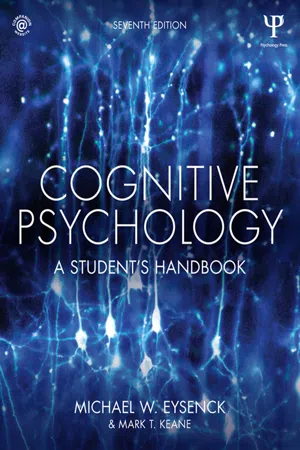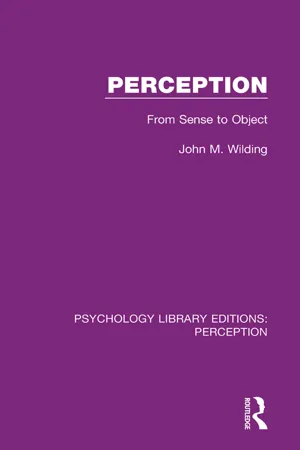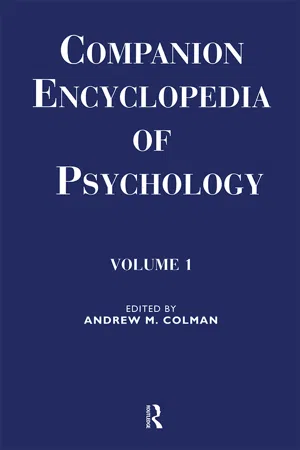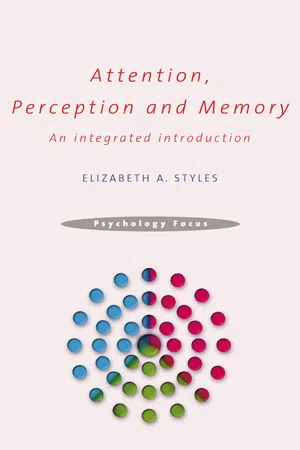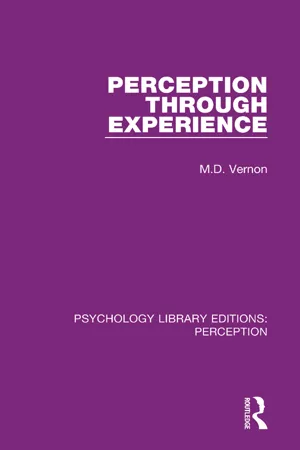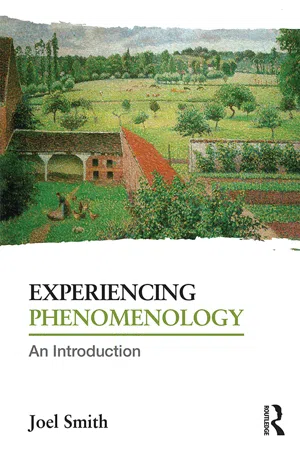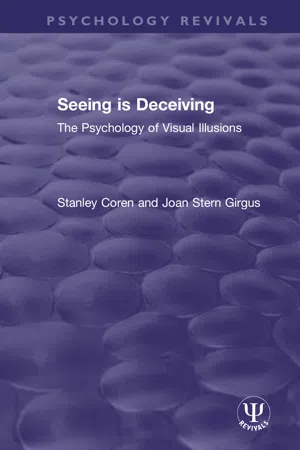Psychology
Visual Cues and Constancies
Visual cues refer to the information that our visual system uses to perceive depth, distance, and size. Visual constancies are the brain's ability to perceive objects as maintaining their size, shape, and color despite changes in the viewing angle or lighting conditions. These cues and constancies play a crucial role in our perception of the visual world.
Written by Perlego with AI-assistance
Related key terms
Related key terms
1 of 4
Related key terms
1 of 3
10 Key excerpts on "Visual Cues and Constancies"
- eBook - ePub
Cognitive Psychology
A Student's Handbook
- Michael W. Eysenck, Mark T. Keane(Authors)
- 2015(Publication Date)
- Psychology Press(Publisher)
Colour constancy is a complex achievement, and observers often fall well short of complete constancy. In view of its complexity, it is unsurprising the visual system adopts an “all hands on deck” approach in which several factors contribute to colour constancy. Of special importance are cone-excitation ratios that remain almost invariant across changes in illumination. In addition, top-down factors such as our memory of the familiar colours of common objects also play a role. Our understanding of the brain mechanisms underlying colour constancy has been enhanced by the discovery of cells in V4 responsive to colour constancy.What are the limitations of theory and research on colour constancy? First, we lack a comprehensive theory of how the various factors combine to produce colour constancy. Second, most research has focused on relatively simple visual environments and so the processes involved in trying to achieve colour constancy in more complex environments are poorly understood. Third, more research is needed to understand why the extent of colour constancy depends greatly on the precise instructions given to observers.Weblink: Cues to depth perceptionDEPTH PERCEPTION
A major accomplishment of visual perception is the transformation of the two-dimensional retinal image into perception of a three-dimensional (3-D) world seen in depth. It is crucially important to us to construct 3-D representations of the world around us if we are to pick up objects, decide whether it is safe to cross the road, avoid cliff edges and so on.Depth perception depends heavily on numerous visual and other cues. We can define a cue as “any sensory information that gives rise to a sensory estimate” (Ernst & Bülthoff, 2004, p. 163).All cues provide ambiguous information, and so it would be unwise to place total reliance on any single cue. In addition, different cues often provide conflicting information. When you watch a movie at the cinema or on television, some cues (e.g., stereo ones) indicate everything you see is at the same distance. In contrast, other cues (e.g., perspective, shading) indicate some objects are closer than others.In real life, cues to depth are often provided by movement of the observer or objects in the visual environment. Some cues are not visual (e.g., based on touch or hearing). However, the major focus here will be on visual depth cues available even if the observer and environmental objects are static. Such cues can conveniently be divided into monocular, binocular and oculomotor cues. Monocular cues are those requiring only one eye, although they can also be used readily when someone has both eyes open. Such cues clearly exist, because the world still retains a sense of depth with one eye closed. Binocular cues are those involving both eyes being used together. Finally, oculomotor cues - eBook - ePub
Perception
From Sense to Object
- John M. Wilding(Author)
- 2017(Publication Date)
- Routledge(Publisher)
A third approach was to invoke information in memory. Knowledge of the correct size or brightness or shape or colour (squirrels are about 30 cm long, grass is a particular shade of green) could, it was argued, be used to correct the sensory information, or memories of sensations associated with walking towards an object or reaching for it could allow its distance to be estimated. What was never explained was how the sensations of the moment, which by definition did not provide the necessary information and could have arisen from a vast number of possible objects, could somehow evoke the right set of sensations in memory. Such an ability would imply pre-existing perception of distance, which again would seem to depend on familiarity with the object, and situations in which a given retinal size of image has in the past been matched with a certain reaching or moving experience. Though such a process might explain my learning of the distance of the book on my desk in front of me, it is difficult to conceive how I ever managed to calibrate the retinal size of an image of a squirrel 30 m away with the sensation of walking 30 m. Conceivably I could have learned a rule for the rate of change in the size of the retinal image as I move, and use that to calculate the size when the object is close to me, but it is not at all clear how structuralists could cope with the learning of rules. Nor is it clear how our generally correct perceptions of the size of novel objects could be explained. Thus none of these three approaches offers a satisfactory solution to the problem of explaining the constancies.Relational cues for perception
With further investigation, however, many possible sources of the necessary information about size and distance have been discovered which make unconscious inferences from distance to size unnecessary. The slight differences in the views received by the two eyes (binocular disparity) were shown to be a powerful cue for distance perception with the invention of the stereoscope, which presents separately to the two eyes pictures giving slightly different views of an object. The most remarkable demonstrations of the effectiveness of this cue have been provided by Julesz (1964) using pairs of dot patterns which when viewed singly appear identical and random. Displacing an area in one of these laterally causes the displaced, and therefore binocularly disparate area, to appear floating in front of or behind the rest of the pattern when they are viewed in a stereoscope (see Frisby 1979, for some delightful examples). Some other cues for distance which do not require binocular vision are the relative blueness of objects (more distant ones appear bluer due to absorption by particles in the air of the longer wavelengths of the light they reflect), relative elevation in the field (more distant objects being higher if on the ground and lower if in the sky), overlap of more distant objects by nearer ones, and the casting of shadows. These cues are obviously different from and not readily reducible to simple sensations. They all depend on relations between different areas of the visual field. Other cues of more complex relational kinds which were later identified by James Gibson will be discussed below. Briefly, Gibson suggests that gradients of change - eBook - ePub
Perception
Theory, Development and Organisation
- Paul Rookes, Jane Willson(Authors)
- 2005(Publication Date)
- Routledge(Publisher)
- Gestalt laws are rather vague and are sometimes difficult to distinguish one from another. The basic law of simplicity is quite hard to define and the simplest interpretation of an ambiguous figure is not always easy to predict.
- Many of the illustrations of organisation apply to very simple stimuli. Complex scenes involving everyday perception do not easily fit into a model based on simple two-dimensional illustrations.
- Eysenck and Keane (1995) suggest that the processes proposed by the Gestalt psychologists probably account only for the early stages of perceptual processing which will be organised later by previous experience.
Perceptual constancies
Constancy is the tendency for qualities of objects to stay the same despite changes in the way we view them. This is an important facet of visual perception. Try to imagine what it would be like if our perceptions were based purely on the image falling on the retina (the proximal stimulus). As you walked along the road towards a post box, it would appear to grow larger. As you moved your arm, your round wrist-watch would appear to change into an elliptical shape. As you moved from natural sunlight outdoors into artificial light indoors, your white shirt would appear yellow. Fortunately for us, our perceptual system seems to ensure that, in most circumstances our distal stimulus (our perceptual experience of objects ‘out there’) remains the same regardless of changes in the proximal stimulus.Size constancy
This is our ability to see objects as remaining more or less the same size as we move closer or further away. The proximal size of an object can shrink and expand, but the distal size of the object seems to stay about the same. If a 6 ft. man walks away from you, you continue to perceive him as man-sized, regardless of his distance from you. It is interesting that this ability to maintain size constancy disappears under certain circumstances. When we look down from a plane, for example, cars and houses really do look like miniatures. When we take a holiday photo of a glorious, panoramic view, we can be quite disappointed with the result. In the photo, those majestic mountains can look quite pathetic. The camera, unlike the human perceiver, only registers angular size and does not compensate for the size changes that are related to distance changes. Our own size constancy mechanism does not appear to work as well when we view pictures as compared to real objects. - eBook - ePub
Perceptual Development in Early Infancy
Problems & Issues
- B. McKenzie, R. H. Day, B. McKenzie, R. H. Day(Authors)
- 2013(Publication Date)
- Psychology Press(Publisher)
It is helpful first to consider briefly the history of the study of size constancy and the situations in which it was first studied. Since size constancy in infancy must necessarily involve a capacity to discriminate object size, evidence for this capacity will also be considered before turning to size constancy itself. Distance discrimination, which is also involved in size constancy is discussed later in the paper.Visual Size Constancy
The relative constancy of visually perceived size with variation in the size of the retinal projection due to changes in distance was the first of the perceptual constancies to be recognized and to receive serious scientific attention. Berkeley (1969 ) mentioned it in his A New Theory of Vision in 1734 and attributed it to simultaneous perception of object distance, a view which still has currency (see Boring, 1942 ). Fechner in 1860 quantified the effect in the near field of vision by matching the apparent separation between one pair of compass points at one distance with the apparent separation between a second pair at another distance. Early systematic studies of size constancy were conducted by Martius (1889 ) using vertical rods placed at different distances and by Hillebrand (1902 ) using frontoparallel extents between a “corridor” of hanging threads, an arrangement that came to be called the vista or alley effect. Later, Thouless (1931 ) and Brunswik (1933 ) recognized visual size constancy as one of a class of effects which they investigated and compared by means of an appropriate common index. Thouless (1931 ) referred to perceptual constancy as “phenomenal regression to the real object” thus characterizing it as a shift of the perceived property away from its retinal representation towards the physical or “real” state of affairs.Visual Size Constancy in Adulthood
For an adult observer viewing under “normal” conditions—binocular vision with unrestricted eye and head movements in a setting rich in texture, pattern and objects—overconstancy of size is usual (Gilinsky, 1955 ; Holway & Boring, 1941 ; Wohlwill, 1963a , 1963b ). This “overshoot” effect occurs for objects as far away as about 1200 m (Gilinsky, 1955 ). The degree of overconstancy varies according to the instructions to the observer, the availability of information or “cues” to distance, and experimental procedures. Carlson (1960 , 1962 - eBook - ePub
Simulated And Virtual Realities
Elements Of Perception
- K. Carr, R. England(Authors)
- 2023(Publication Date)
- CRC Press(Publisher)
The key problem of visual recognition is that a vast variety of different patterns of stimulation can elicit the same categorical classification. The light levels reflected from an object vary with the incident illumination sources, which change throughout the day and whenever nearby reflecting surfaces are moved. The orientation of the object’s projection on the retina varies depending on both the object’s position in the environment and the observer’s viewpoint. As an observer walks around a 3-D object, different retinal projections of the image occur and the visual system needs to identify that these different images are from the same object. Likewise, retinal size is dependent on viewing distance. The general term ‘object constancy’ is used to denote the ability to recognize the invariance of objects in the face of this multitude of changes.Recognition is possible on the basis of representations which are degraded in various ways, for example when part of the object is occluded. Except where specific camouflage is involved, recognition is remarkably unhindered by visual backgrounds or scene context although, as we discuss in section 6.3.3 , context information can facilitate the recognition process. Finally, objects can be recognized from seemingly much impoverished representations of the real stimulus, such as line drawings.A key question in understanding human object recognition is to know how peripheral visual mechanisms might operate to promote object constancy. It is generally accepted for example that retinal adaptation mechanisms ensure that the brain receives a spatial visual signal which is largely independent of the level of scene illumination. Marr’s (1982) proposal that an early stage in vision is the formation of a primal sketch might be seen as a further mechanism for ignoring irrelevant illumination variations. Some workers have suggested that mental transformations equivalent to image rotation and zoom lens scaling may be achieved by basic visual mechanisms and may be important in visual recognition (as will be shown in sections 6.2.2 and 6.3.1). - eBook - ePub
Companion Encyclopedia of Psychology
Volume One
- Andrew M. Colman(Author)
- 2018(Publication Date)
- Routledge(Publisher)
This spatial image is reproduced, at least approximately, in the visual cortex of the brain (Figure 1). We call the image in the eye the "retinal image"; some but by no means all the properties of seeing can be understood in terms of it. The retinal image depends on the optical properties of both the environment and the eye. As Figure 3 shows, the size of the image depends on the distance between eye and object, but we know very well that perceived size does not vary to anything like the degree to be expected in these terms. Your friends do not suddenly shrink in size as they move away from you! This discrepancy between what the retinal image might lead one to expect, and the actual "phenomenological" appearance (that is, how things really appear to the observer) is called perceptual constancy, and occurs not only for size, but also for shape, colour, and brightness, among others. In each case what is meant by constancy is the fact that what one sees (the phenomenon) is far less variable than what an analysis of the optical and other physical features of the stimulating environment would lead one to expect. To take another example, consider the appearance of a book with a blue cover. You look at it in bright daylight, or in the artificial illumination of a neon lamp, you stretch out the arm that holds it, or turn it away from you. In each case the stimulation reaching your retina implies (if it does not demand) that what you see should vary markedly. Yet what you do see is a book with quite stable visual characteristics. Constancy has done its job without your cooperation or awareness - eBook - ePub
Attention, Perception and Memory
An Integrated Introduction
- Elizabeth Styles(Author)
- 2004(Publication Date)
- Psychology Press(Publisher)
Although the difference between the information arriving from the two eyes is important, it is only useful for judging depth within a close range of the observer. Fortunately there are many more sources of information about depth, size and distance that do not require us to use both eyes at once and that are useful for much greater distances from the observer. For example, pictures are only two-dimensional yet we can gain the impression of depth; these pictorial cues are monocular cues to depth and are often used by artists to give the illusion of three-dimensional space. Familiar size You see your friend running towards you. As they approach they get larger and larger: however, you know your friend is coming closer, not actually growing. This is because you have knowledge in your memory about the size of people and know that people do not rapidly change size. In fact, the retinal image is expanding, and the rate of expansion is an indication of how fast something, in this case your friend, is approaching. Likewise, as a car passes you and moves off into the distance, it appears to get smaller. However, it is known that perception of size does not vary as much as would be expected from the change in size of the retinal image. This is an example of perceptual constancy, in this case size constancy. Basically we experience a car moving away, or a person coming nearer. We do not concern ourselves with the changing size; we interpret the information as giving movement in the depth plane. It is very important that we have stored knowledge about the size of objects, because the retinal image is ambiguous. We can see this in Figure 4.2. The human figure appears to be small, but because we know the normal size of a human we infer it is in the distance and therefore the statue must be very large. So, what we have here is an example of the way in which non-visual information is added to retinal information to compute size - eBook - ePub
- M.D. Vernon(Author)
- 2017(Publication Date)
- Routledge(Publisher)
The Constancies(1) Introduction
A form of interaction between ‘figure’ and ‘ground’ in perception which has given rise to continued speculation and an enormous amount of experimental investigation is that which occurs in the so-called ‘constancies’. It appears that an object may retain the shape, size and colour which are characteristically associated with its identity although the information as to these qualities which is projected to the eye varies with variation in the relation of the object to its surroundings. We noted in Chapter II that infants learnt to identify objects and to disregard changes in the sensory data related to shape which occur when the objects are tilted or rotated; and changes in projected size which are produced by varying the distance of the object from the eye. So also it is found that from an early age children and adults may seem actually to perceive a rotated shape as having the same form as that of the unrotated shape; or perceive a form part-way between that of the unrotated shape and that of the actually projected shape. And they may perceive the size of a distant object to approximate to the size of the same object when it is close to them. Finally, they may perceive the brightness and colour to vary less than do the brightness and colour of the projected image. But the preservation of perceived constancy in spite of variation in the projected sensory data depends to a large extent on the ability of the observer to differentiate the inherent qualities of the object from those aspects which vary with changes in the environmental setting. Thus in general it is necessary for the observer to perceive the characteristics of the environmental setting or ‘ground’ clearly and unambiguously.These phenomena were first described independently by Thouless (1931a and 1931b) and by the Gestalt psychologists, notably Koffka (1935). The former termed them ‘phenomenal regression to the real object’, and the latter, the ‘constancies - eBook - ePub
Experiencing Phenomenology
An Introduction
- Joel Smith(Author)
- 2016(Publication Date)
- Routledge(Publisher)
This is the phenomenon of perceptual constancy which, as can be seen, presents a puzzle about the way that things appear. Whilst the above examples all concern vision, similar phenomena occur in other modalities. Consider, for example, how the volume of the noise made by a pneumatic drill alters yet stays constant as one walks towards it.Perceptual constancy has been a central topic within psychology and philosophy for some time, but the term was coined by the Gestalt psychologists in the 1920s. Since different theorists use the term to refer to a variety of distinct yet related phenomena, it is important to be clear about how I am using it here. By ‘perceptual constancy’ I mean the phenomenon of some thing’s properties (shape, size, colour, etc.) appearing to remain constant through differences in the way that the object seems with respect to that property. Understood in this way, perceptual constancy concerns appearances and is, therefore, something that clearly falls within the province of phenomenology. This phenomenological understanding of constancy is our topic (it contrasts with the related, but distinct, understanding of constancy as the discrepancy between a thing’s apparent properties and the properties of the retinal image of that thing).The phenomenological understanding of perceptual constancy poses a challenge for the description of things as they appear. How can it be that, for example, a thing’s colour can be given as both constant and varied? Before looking at Husserl’s and Merleau-Ponty’s answers to this question, however, we should briefly consider the view that no such answer is required since there is in fact no such phenomenon as perceptual constancy, so described. - eBook - ePub
Seeing is Deceiving
The Psychology of Visual Illusions
- Stanley Coren, Joan Girgus(Authors)
- 2020(Publication Date)
- Routledge(Publisher)
It may be the case that individuals who show good size constancy in three-dimensional displays are more sensitive to any available depth cues. This means that they might also be more responsive to the flatness cues in the illusion array, which would serve to attenuate the correlation between naturally occurring size constancy processes and those evoked in picture processing and possibly in illusion formation. It may also be the case that the range of size constancy abilities found in a given culture is too restricted; hence one must rely on the cross-cultural manipulation to obtain the range of variation necessary to produce significant correlations. Nonetheless, such results raise questions about theories based on a necessary relationship between size constancy strategies, pictorial perception, and illusion formation.SUMMARY OF CONSTANCY SCALING AND ILLUSIONS
Constancy scaling theories of visual illusions have probably had more impact on the field than any other theory or set of theories. They have often provoked rather heated debates. Looking back across the data we have summarized in this chapter, it is clear that there is a large body of data that seems to be consistent with, and predicted by, such a theoriteical approach. It also is clear that there are many predictions made by such a theory that are not supported by the data. On the basis of the positive evidence, it is safe to suggest that depth processing plays a contributory role in the formation of some illusions. The existence of contradictory evidence leads us to temper this conclusion and suggests that constancy scaling processes are probably moderated by other mechanisms that may predominate in certain illusion patterns. It may well be that some investigators have asked too much of this theory. They have argued against it on the grounds that there are variants of some classical illusions that lack any apparent depth cue (Day, 1965; Hotopf, 1966; Zanforlin, 1967). Such arguments would be cogent only if one expects picture processing to provide the sole
Index pages curate the most relevant extracts from our library of academic textbooks. They’ve been created using an in-house natural language model (NLM), each adding context and meaning to key research topics.
Explore more topic indexes
Explore more topic indexes
1 of 6
Explore more topic indexes
1 of 4
